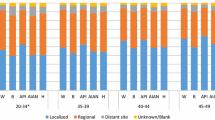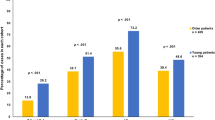Abstract
Background
Women ≤ 40 years account for 5% of new breast cancer diagnoses. Although there is increased awareness of genetic and other breast cancer risk factors, it is not clear whether this has resulted in earlier diagnosis in young women.
Methods
A database review identified 8892 women treated for breast cancer from 1980 to 2002. We compared 925 women aged ≤ 40 years with 2362 women aged 50 to 60 years. The mean and median tumor size and lymph node status were determined for each group.
Results
There were significant differences in tumor size and lymph node status in younger versus older women. From 1980 to the mid 1990s, tumor size and nodal status did not differ. Since the mid 1990s, tumor size has decreased more rapidly for women aged 50 to 60 years than for those ≤ 40 years. In 1998 to 2002, the mean tumor size reached a plateau of 1.8 cm in women 50 to 60 years, compared with a plateau of 2.4 cm in women ≤ 40 years (P < .001). The median tumor size in 1998 to 2002 was 1.4 cm in women 50 to 60 years compared with 1.9 cm in women ≤ 40 years (P < .001). Lymph node status was also significantly different during 1998 to 2002: 23.9% positive in women 50 to 60 years versus 35.2% in women ≤ 40 years (P < .001).
Conclusions
Since the 1980s, women aged 50 to 60 years have enjoyed a greater decrease in tumor size and percentage with positive nodes. These data could be the result of ineffective screening of younger women or of more aggressive tumor biology. Further study is required to determine whether more effective identification and screening of young, high-risk women can result in earlier detection.





Similar content being viewed by others
References
Ries LA, Eisner MP, Kosary CL, et al. SEER Cancer Statistics Review, 1973–1997. National Cancer Institute, Bethesda, MD, USA 2000
Greenlee RT, Murray T, Bolden S, et al. Cancer Statistics, 2000. CA Cancer J Clin 2000;50:7–33
Tabar L, Duffy SW, Vitak B, Chen HH, Prevost TC. The natural history of breast carcinoma: what have we learned from screening? Cancer 1999;86:449–62
Shapiro S. Periodic screening for breast cancer: the HIP Randomized Controlled Trial. Health Insurance Plan. J Natl Cancer Inst Monogr 1997;22:27–30
Tabar L, Fagerberg G, Duffy SW, et al. The Swedish Two-County Trial of mammographic screening for breast cancer: recent results and calculation of benefit. J Epidemiol Community Health 1989;43:107–14
Miller AB, Baines CJ, To T, et al. Canadian National Breast Screening Study: 2. Breast cancer detection and death rates among women aged 50 to 59 years. Can Med Assoc J 1992;147:1477–88
Gotzsche PC, Olsen O. Is screening for breast cancer with mammography justifiable? Lancet 2000;355:129–34
Smith RA. Breast cancer screening among women younger than age 50: a current assessment of the issues. CA Cancer J Clin 2000;50:312–36
Humphrey LL, Helfand M, Chan B, Woolf S. Breast cancer screening: a summary of the evidence for the U.S. Preventive Services Task Force. Ann Intern Med 2002;137:347–60
Kopans D. The breast cancer screening controversy: lessons to be learned. J Surg Oncol 1998;67:143–50
Tabar L, Fagerber G, Chen HH, et al. Efficacy of breast cancer screening by age. New results from the Swedish Two-County Trial. Cancer 1995;75:2507–17
Miller AB, To T, Baines CJ, Wall C. The Canadian National Breast Cancer Screening Study-1: breast cancer mortality after 11 to 16 years of follow-up. A randomized screening trial of mammography in women age 40-49 years. Ann Intern Med 2002;137:305–12
Nystrom L, Andersson I, Bjurstam N, Frisell J, Nordenskjold B, Rutqvist LE. Long-term effects of mammography screening: updated overview of the Swedish randomized trials. Lancet 2002;359:909–19
Miller AB, Baines CJ, To T, et al. Canadian National Breast Screening Study: 1. Breast cancer detection and death rates among women aged 40 to 49 years. Can Med Assoc J 1992;147:1459–76
Fletcher SW, Black W, Harris R, et al. Report of the International Workshop on Screening for Breast Cancer. J Natl Cancer Inst 1993;85:1644–56
Smith RA, Saslow D, Sawyer KA, et al. American Cancer Society guidelines for breast cancer screening. CA Cancer J Clin 2003;53:141–69
Cancer Facts and Figures 2004. American Cancer Society, Atlanta, GA, USA. 2004
Gajdos C, Tartter PI, Bleiweiss IF, Bodian C, Brower ST. Stage 0 to stage III breast cancer in young women. J Am Coll Surg 2000;190:523–29
Kollias J, Elston DW, Ellis IO, et al. Early-onset breast cancer—histopathological and prognostic consideration. Br J Cancer 1997;75:1318–23
Fowble BL, Schultz DJ, Overmoyer B, et al. The influence of young age on outcome in early stage breast cancer. Int J Radiat Oncol Biol Phys 1994;30:23–33
De La Rochefordiere A, Asselain B, Campana F, et al. Age as prognostic factor in premenopausal breast carcinoma. Lancet 1993;341:1039–43
Fox S, Baum JK, Klos DS, Tsou CV. Breast cancer screening: the underuse of mammography. Radiology 1985;156:607–11
Physician Insurers Association of America 2002 Breast Cancer Study. Physician Insurers Association of America, Rockville, MD, USA, 2002
Colbert JA, Kaine EM, Bigby J, et al. The age at which women begin mammographic screening. Cancer 2004;101:1850–59
Michaelson JS, Silverstein M, Wyatt J, et al. Predicting the survival of patients with breast carcinoma using tumor size. Cancer 2002;95:713–23
Joensuu H, Lehtimaki T, Holli T, et al. Risk of distant recurrence of breast cancer detected by mammography screening or other methods. JAMA 2004;292:1064–73
Michaelson JS, Silverstein M, Sgroi D, et al. The effect of tumor size and lymph node status on breast carcinoma lethality. Cancer 2003;98:2133–43
Smith B, Dees E, MacDonald D, Lawlor C, Souba W. Detection of breast cancer under age 40: implications for screening of high-risk women (abstract). Society of Surgical Oncology, Chicago, IL, USA 1997
Stoutjeskijk MJ, Boetes C, Jager GJ, et al. Magnetic resonance imaging and mammography in women with a hereditary risk of breast cancer. J Natl Cancer Inst 2001;93:1095–102
Kriege M, Brekelmans CTM, Boetes C, et al. MRI screening for breast cancer in women with familial or genetic predisposition. Fam Cancer 2001;1:163–8
Kuhl CK, Schmutzler RK, Leutner CC, et al. Breast MR imaging screening in 192 women proved or suspected to be carriers of a breast cancer susceptibility gene: preliminary results. Radiology 2000;215:267–79
Warner E, Plewes D, Hill K, et al. Surveillance of BRCA1 and BRCA2 mutation carriers with magnetic resonance imaging, ultrasound, mammography, and clinical breast examination. JAMA 2004;292:1317–25
Tilanus-Linthorst M, Verhoog L, Obdeijn IM, et al. A BRCA1/2 mutation, high breast density and prominent pushing margins of a tumor independently contribute to a frequent false-negative mammography. Int J Cancer 2002; 102:91–5
Chen HH, Duffy SW, Tabar L, Day NE. Markov chain models for progression of breast cancer, part 1: tumor attributes and the preclinical screen-detectable phase. J Epidemiol Biostat 1997;2:9–23
Kopans DB, Rafferty E, Georgian-Smith D, et al. A simple model of breast carcinoma growth may provide explanations for observations of apparently complex phenomena. Cancer 2003;97:2951–59
Shaw de Paredes E, Marsteller LP, Eden BV. Breast cancers in women 35 years of age and younger: mammographic findings. Radiology 1990;177:117–19
Blanchard K, Colbert JA, Puri D, et al. Mammographic screening: patterns of use and estimated impact on breast carcinoma survival. Cancer 2004;101:495–507
Author information
Authors and Affiliations
Corresponding author
Rights and permissions
About this article
Cite this article
Zabicki, K., Colbert, J.A., Dominguez, F.J. et al. Breast Cancer Diagnosis in Women ≤ 40 versus 50 to 60 Years: Increasing Size and Stage Disparity Compared With Older Women Over Time. Ann Surg Oncol 13, 1072–1077 (2006). https://doi.org/10.1245/ASO.2006.03.055
Received:
Accepted:
Published:
Issue Date:
DOI: https://doi.org/10.1245/ASO.2006.03.055




